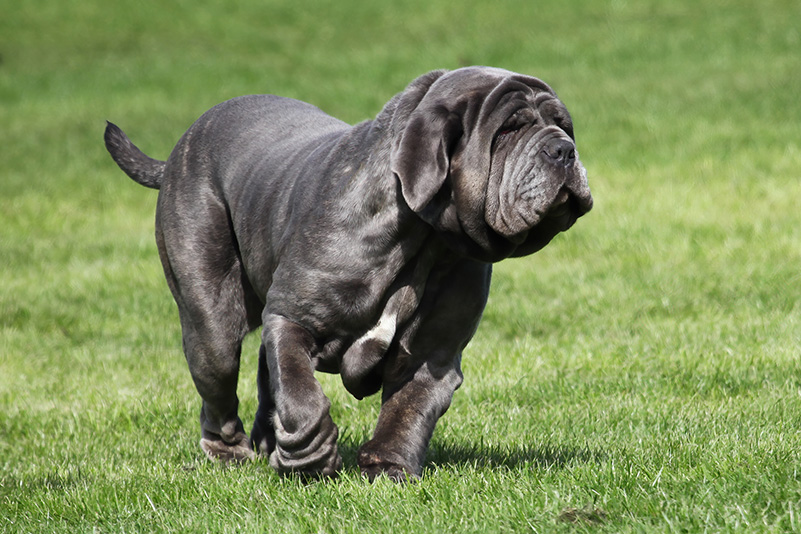Neapolitan Mastiff

Description
The Neapolitan Mastiff is a large, powerful breed of dog that is known for its imposing size, distinct wrinkled skin, and protective nature. Originally from Italy, this breed was developed to guard homes and estates, and it still retains its role as a loyal and formidable guardian. The Neapolitan Mastiff is often described as a "gentle giant," as despite its intimidating appearance, it is generally calm, affectionate, and devoted to its family. Its history can be traced back to ancient times, where it is believed to have descended from large Molossian dogs used by the Romans in battle and as guard dogs.
Physically, the Neapolitan Mastiff is an imposing presence, with males often standing 26 to 31 inches tall at the shoulder and weighing between 110 to 150 pounds or more. Their most distinctive feature is their loose, wrinkled skin, particularly around the face and neck, which gives them a unique, almost exaggerated appearance. The breed has a muscular build, with a broad chest and powerful legs. Their coat is short, smooth, and typically comes in colors like blue, black, mahogany, or tawny, often with a darker mask on the face.
Despite their intimidating size and appearance, Neapolitan Mastiffs are known for their calm and gentle temperament, especially with their families. They are deeply loyal and protective of their loved ones, making them excellent guard dogs. However, they are not aggressive by nature and generally exhibit a calm demeanor unless they sense a threat to their home or family. Early socialization and consistent training are important to ensure that they are well-behaved and comfortable around strangers and other animals. With proper guidance, they can be loving companions, especially for families who appreciate their quiet and dignified presence.
Neapolitan Mastiffs tend to be relatively low-energy compared to other breeds, preferring to lounge around the home rather than engage in high-intensity activities. Despite their size, they are usually content with moderate exercise, such as daily walks, and enjoy spending time with their family. Their calm and affectionate nature also makes them good with children, although their size means they should be monitored around young kids to prevent accidental knocks or falls.
In terms of care, the Neapolitan Mastiff's distinctive wrinkles require regular attention to keep them clean and free from irritation. Their loose skin can trap moisture, which, if left unchecked, can lead to infections. Regular bathing, skin folds cleaning, and eye care are necessary to maintain their health. Due to their size, they are also prone to certain health issues, such as hip dysplasia and heart problems, so regular veterinary check-ups are essential.
In summary, the Neapolitan Mastiff is a noble and protective breed, known for its impressive size, striking appearance, and loyal temperament. While their physical presence can be intimidating, they are gentle giants who make affectionate and devoted family companions when properly trained and cared for. With their unique look and calm demeanor, the Neapolitan Mastiff remains a beloved breed among dog lovers who are prepared for the responsibility of caring for such a large and powerful dog.
History
The Neapolitan Mastiff, or *Mastino Napoletano*, is an ancient and powerful breed with roots tracing back to the Molossus dogs of ancient Mesopotamia and the Roman Empire. These large, muscular dogs were originally bred as war dogs and guardians, known for their imposing presence and fearlessness in battle. The Molossus dogs were brought to Italy by the Romans, where they were further developed into the ancestors of the modern Neapolitan Mastiff. In Roman times, they served not only in warfare but also in arenas, fighting wild animals for entertainment, and as protectors of estates and livestock.
After the fall of the Roman Empire, these dogs found a more utilitarian role in rural southern Italy, particularly around Naples, where they became essential as guard dogs for farms and estates. Their massive size, loose skin, and protective instincts made them effective deterrents against intruders and predators. The breed was kept alive through centuries of selective breeding by local farmers and peasants, who valued the Mastino’s loyalty, strength, and intimidating appearance.
By the mid-20th century, the Neapolitan Mastiff was on the brink of extinction, as its numbers dwindled due to changes in agricultural practices and urbanization. Italian painter and dog enthusiast Piero Scanziani played a pivotal role in preserving the breed. In the 1940s, Scanziani began collecting and breeding the remaining Neapolitan Mastiffs, working to standardize their appearance and traits. In 1949, the breed was officially recognized by the Italian Kennel Club, and its revival gained momentum.
Today, the Neapolitan Mastiff is celebrated worldwide for its unique appearance, characterized by its massive build, loose, wrinkled skin, and expressive eyes. While it retains its role as a guardian, it is also cherished as a loyal and affectionate family companion. The breed’s history reflects its resilience and the dedication of those who ensured its survival, preserving its legacy as a symbol of strength and protection.
Colors
• Black
• Blue
• Mahogany
• Tawny


